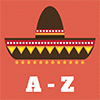 Traditional pieces of the male and female national costumes in Palestine: abaya, bisht, burnous, bushnika, damer, dimaya, hata wi ‘agal, izar, jallayeh, jubba, jubbeh, khabara, kuffiyah, laffeh, lavandi, malliaia, qamis, qibar, qumbaz, salta, sirwal, tarbush, tatriz, taqiyyah, taqsireh, and thob.
Traditional pieces of the male and female national costumes in Palestine: abaya, bisht, burnous, bushnika, damer, dimaya, hata wi ‘agal, izar, jallayeh, jubba, jubbeh, khabara, kuffiyah, laffeh, lavandi, malliaia, qamis, qibar, qumbaz, salta, sirwal, tarbush, tatriz, taqiyyah, taqsireh, and thob.
Abaya – traditional high-quality outerwear; festive cloak. Both men and women wear abaya, though female garment is much more decorated.
Bisht – traditional high-quality outerwear; variation of abaya. Actually, this is a short abaya with long sleeves. Worn by both men and women.
Burnous – female outerwear; waist-long cloak with a hood.
Bushnika – Palestinian traditional women’s headdress. It is a scarf with a floral pattern.
Damer – male outerwear. It is the traditional short robe with long wide sleeves. This garment is also called “jubba”.
Dimaya – Palestinian male kaftan or long robe. It is tight-fitting at the top and widening a bit to the bottom. One flap of the robe is put over the other. The collar is round. There are also long slits at the sides of the kaftan. This garment is also called “qumbaz” or “qibar”.
Hata wi ‘agal – traditional men’s headdress. It is a large square piece of silk or cotton cloth that was held in place on the head with a help of agal, a circle of cord.
Izar – ancient Palestinian female garment. It is a wrap-around cloth made from white linen or cotton fabric.
Jallayeh (jillayeh) – women’s jacket decorated with embroidery and appliqué.
Jubba – male outerwear. It is the traditional short robe with long wide sleeves. This garment is also called “damer”.
Jubbeh – traditional jacket worn by both men and women.
Khabara – ancient female outfit in Palestine. It is a wrap-around cloth made from black silk (sometimes other colors were used). Khabara had a lacing; the upper part of the garment covered the shoulders and the bottom part widened and formed a skirt.
Kuffiyah – popular traditional headdress. The Palestinian kuffiyah was a large scarf worn around the head and neck. It was used by both men and women.
Laffeh – part of the traditional headdress. It is a piece of silk or cotton cloth wrapped over the tarbush.
Lavandi – men’s wide belt.
Malliaia – female cloak with long sleeves. It was made from black or colored silk.
Qamis – traditional undershirt. It is made from white or beige cotton or fine wool. Qamis is long (in some areas, knee-length and in other, ankle-length). The sleeves also are long.
Qibar – Palestinian male kaftan or long robe. It is tight-fitting at the top and widening a bit to the bottom. One flap of the robe is put over the other. The collar is round. There are also long slits at the sides of the kaftan. This garment is also called “qumbaz” or “dimaya”.
Qumbaz – Palestinian male kaftan or long robe. It is tight-fitting at the top and widening a bit to the bottom. One flap of the robe is put over the other. The collar is round. There are also long slits at the sides of the kaftan. This garment is also called “qibar” or “dimaya”.
Salta – male outerwear. It is the traditional short robe with short sleeves.
Sirwal (shirwal) – traditional baggy trousers used by both men and women. They are long and wide, tied with a cord at the waist. The color of the fabric is usually black, dark blue, or white – for men, and colorful for women. The material is most often cotton.
Tarbush – male red hat similar to the Ottoman-style fez. Females also wear tarbush but it looks different.
Tatriz – Palestinian traditional embroidery.
Taqiyyah – male folk headdress; small cotton skull-cap. It was often worn under the hata wi ‘agal.
Taqsireh – female jacket used in Palestine. It is a short garment (it reached midriff) with short sleeves and a lot of embroidery.
Thob – basic Palestinian garment; a robe. It is a long loose garment with long sleeves. Its cut and decorations depended on the region of origin.


